
Illustrative Math Alignment: Grade 8 Unit 2
Dilations, Similarity, and Introducing Slope
Lesson 10: Meet Slope
Use the following Media4Math resources with this Illustrative Math lesson.
| Thumbnail Image | Title | Body | Curriculum Topic |
|---|---|---|---|
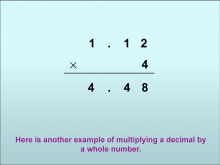
|
Math Clip Art--Using Place Value to Multiply Decimals by Whole Numbers 08 | Math Clip Art--Using Place Value to Multiply Decimals by Whole Numbers 08
This is part of a collection of math clip art images that show how to use place value to add and multiply numbers. |
Multiply Decimals and Place Value |
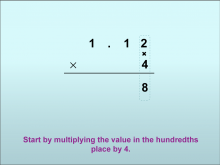
|
Math Clip Art--Using Place Value to Multiply Decimals by Whole Numbers 09 | Math Clip Art--Using Place Value to Multiply Decimals by Whole Numbers 09
This is part of a collection of math clip art images that show how to use place value to add and multiply numbers. |
Multiply Decimals and Place Value |
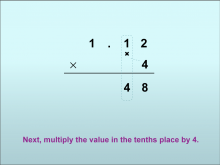
|
Math Clip Art--Using Place Value to Multiply Decimals by Whole Numbers 10 | Math Clip Art--Using Place Value to Multiply Decimals by Whole Numbers 10
This is part of a collection of math clip art images that show how to use place value to add and multiply numbers. |
Multiply Decimals and Place Value |
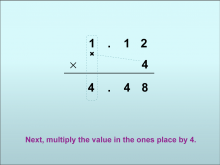
|
Math Clip Art--Using Place Value to Multiply Decimals by Whole Numbers 11 | Math Clip Art--Using Place Value to Multiply Decimals by Whole Numbers 11
This is part of a collection of math clip art images that show how to use place value to add and multiply numbers. |
Multiply Decimals and Place Value |
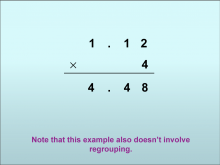
|
Math Clip Art--Using Place Value to Multiply Decimals by Whole Numbers 12 | Math Clip Art--Using Place Value to Multiply Decimals by Whole Numbers 12
This is part of a collection of math clip art images that show how to use place value to add and multiply numbers. |
Multiply Decimals and Place Value |
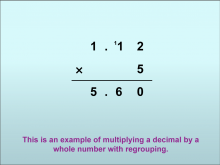
|
Math Clip Art--Using Place Value to Multiply Decimals by Whole Numbers 13 | Math Clip Art--Using Place Value to Multiply Decimals by Whole Numbers 13
This is part of a collection of math clip art images that show how to use place value to add and multiply numbers. |
Multiply Decimals and Place Value |
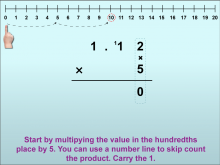
|
Math Clip Art--Using Place Value to Multiply Decimals by Whole Numbers 14 | Math Clip Art--Using Place Value to Multiply Decimals by Whole Numbers 14
This is part of a collection of math clip art images that show how to use place value to add and multiply numbers. |
Multiply Decimals and Place Value |
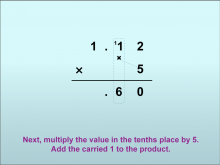
|
Math Clip Art--Using Place Value to Multiply Decimals by Whole Numbers 15 | Math Clip Art--Using Place Value to Multiply Decimals by Whole Numbers 15
This is part of a collection of math clip art images that show how to use place value to add and multiply numbers. |
Multiply Decimals and Place Value |
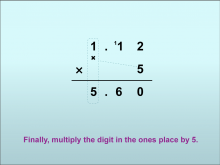
|
Math Clip Art--Using Place Value to Multiply Decimals by Whole Numbers 16 | Math Clip Art--Using Place Value to Multiply Decimals by Whole Numbers 16
This is part of a collection of math clip art images that show how to use place value to add and multiply numbers. |
Multiply Decimals and Place Value |
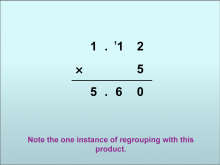
|
Math Clip Art--Using Place Value to Multiply Decimals by Whole Numbers 17 | Math Clip Art--Using Place Value to Multiply Decimals by Whole Numbers 17
This is part of a collection of math clip art images that show how to use place value to add and multiply numbers. |
Multiply Decimals and Place Value |

|
Math Clip Art--Using Place Value to Multiply Decimals by Whole Numbers 18 | Math Clip Art--Using Place Value to Multiply Decimals by Whole Numbers 18
This is part of a collection of math clip art images that show how to use place value to add and multiply numbers. |
Multiply Decimals and Place Value |
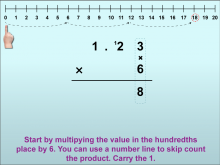
|
Math Clip Art--Using Place Value to Multiply Decimals by Whole Numbers 19 | Math Clip Art--Using Place Value to Multiply Decimals by Whole Numbers 19
This is part of a collection of math clip art images that show how to use place value to add and multiply numbers. |
Multiply Decimals and Place Value |
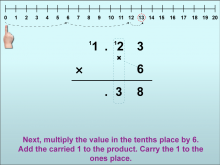
|
Math Clip Art--Using Place Value to Multiply Decimals by Whole Numbers 20 | Math Clip Art--Using Place Value to Multiply Decimals by Whole Numbers 20
This is part of a collection of math clip art images that show how to use place value to add and multiply numbers. |
Multiply Decimals and Place Value |
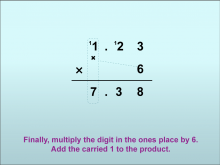
|
Math Clip Art--Using Place Value to Multiply Decimals by Whole Numbers 21 | Math Clip Art--Using Place Value to Multiply Decimals by Whole Numbers 21
This is part of a collection of math clip art images that show how to use place value to add and multiply numbers. |
Multiply Decimals and Place Value |

|
Math Clip Art--Using Place Value to Multiply Decimals by Whole Numbers 22 | Math Clip Art--Using Place Value to Multiply Decimals by Whole Numbers 22
This is part of a collection of math clip art images that show how to use place value to add and multiply numbers. |
Multiply Decimals and Place Value |

|
Math Clip Art: Images of Staircases | Use this selection of images to show steepness of stairs as a way of introducing the concept of slope. |
Slope |
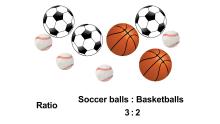
|
Math Clip Art: Slope vs. Rate | Math Clip Art: Slope vs. Rate In these clip art images, show students the difference between ratios and rates. These images are useful when talking about slope as both a ratio and a rate. In particular, this is useful when talking about slope as a rate of change. |
Slope and Ratios and Rates |

|
Math Clip Art: Slopes of Lines | Math Clip Art: Slopes of Lines Have students compare the slopes of the pairs of lines from these clip art images. Have them use the background grid for measuring the rise and the run. |
Slope |
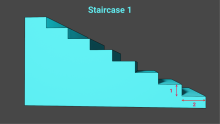
|
Math Clip Art: Staircase Steepness | In this set of clip art images, different values for the rise and run are given, but in all cases they result in the same slope for the staircase. These images help advance the idea that slope is a ratio and proportion. |
Slope |
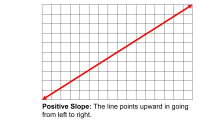
|
Math Clip Art: Types of Slope | Math Clip Art: Types of Slope Use these clip art images to show the different types of slope available. These slope types are covered: Positive SlopeNegative SlopeZero SlopeNo SlopeSlope = 1Slope =-10 < Slope < 1Slope > 1 |
Slope |
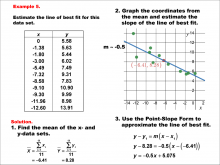
|
Math Example--Charts, Graphs, and Plots--Estimating the Line of Best Fit: Example 5 | Math Example--Charts, Graphs, and Plots-- Estimating the Line of Best Fit: Example 5
In this set of math examples, analyze the behavior of different scatterplots. This includes linear and quadratic models. |
Point-Slope Form, Slope-Intercept Form and Data Analysis |
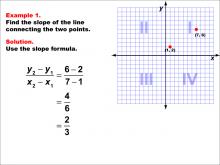
|
Math Example--Coordinate Geometry--Slope Formula: Example 1 | Math Example--Coordinate Geometry--Slope Formula: Example 1TopicSlope Formula DescriptionThis example demonstrates how to calculate the slope of a line connecting two points on a coordinate grid. The points (1, 2) and (7, 6) are plotted, and the slope formula is applied to find the slope between them. The calculation shows that the slope is (6 - 2) / (7 - 1) = 4 / 6 = 2 / 3. The slope formula is a fundamental concept in coordinate geometry, allowing us to determine the steepness and direction of a line. It's essential for understanding linear relationships and is widely used in various mathematical and real-world applications. |
Slope |
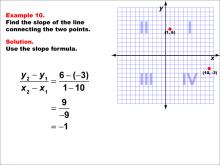
|
Math Example--Coordinate Geometry--Slope Formula: Example 10 | Math Example--Coordinate Geometry--Slope Formula: Example 10TopicSlope Formula DescriptionThis example illustrates the calculation of slope for a line connecting two points: (1, 6) and (10, -3) on a Cartesian plane. Applying the slope formula, we find that the slope is (6 - (-3)) / (1 - 10) = 9 / -9 = -1. The slope formula is a crucial concept in coordinate geometry, helping us understand the steepness and direction of lines. This example demonstrates how to handle points with both positive and negative coordinates when calculating slope, resulting in a negative slope. |
Slope |
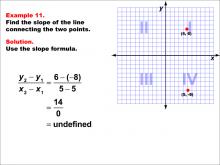
|
Math Example--Coordinate Geometry--Slope Formula: Example 11 | Math Example--Coordinate Geometry--Slope Formula: Example 11TopicSlope Formula DescriptionThis example demonstrates the calculation of slope for a vertical line connecting points (5, 6) and (5, -8) on a Cartesian plane. When we apply the slope formula, we find that the slope is (6 - (-8)) / (5 - 5) = 14 / 0, which is undefined. The slope formula is a key concept in coordinate geometry, helping us understand the steepness and direction of lines. This particular example highlights a special case where the line is vertical, resulting in an undefined slope. |
Slope |
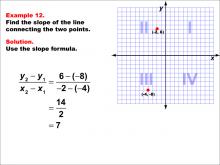
|
Math Example--Coordinate Geometry--Slope Formula: Example 12 | Math Example--Coordinate Geometry--Slope Formula: Example 12TopicSlope Formula DescriptionThis example illustrates the calculation of slope for a line connecting two points: (-2, 6) and (-4, -8) on a Cartesian plane. Applying the slope formula, we find that the slope is (6 - (-8)) / (-2 - (-4)) = 14 / 2 = 7. The slope formula is a fundamental concept in coordinate geometry, helping us understand the steepness and direction of lines. This example demonstrates how to handle points with negative coordinates when calculating slope, resulting in a positive slope. |
Slope |
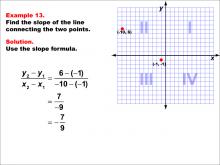
|
Math Example--Coordinate Geometry--Slope Formula: Example 13 | Math Example--Coordinate Geometry--Slope Formula: Example 13TopicSlope Formula DescriptionThis example demonstrates the calculation of slope for a line connecting two points: (-10, 6) and (-1, -1) on a Cartesian plane. The line crosses quadrants II and III. Applying the slope formula, we find that the slope is (6 - (-1)) / (-10 - (-1)) = 7 / -9 = -7 / 9. The slope formula is a crucial concept in coordinate geometry, helping us understand the steepness and direction of lines. This example shows how to handle points in different quadrants and with negative coordinates when calculating slope. |
Slope |
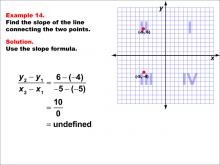
|
Math Example--Coordinate Geometry--Slope Formula: Example 14 | Math Example--Coordinate Geometry--Slope Formula: Example 14TopicSlope Formula DescriptionThis example illustrates the calculation of slope for a vertical line passing through two points: (-5, 6) and (-5, -4) in Quadrant II of a Cartesian plane. When we apply the slope formula, we find that the slope is (6 - (-4)) / (-5 - (-5)) = 10 / 0, which is undefined. The slope formula is a key concept in coordinate geometry, helping us understand the steepness and direction of lines. This particular example highlights a special case where the line is vertical, resulting in an undefined slope. |
Slope |
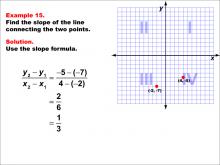
|
Math Example--Coordinate Geometry--Slope Formula: Example 15 | Math Example--Coordinate Geometry--Slope Formula: Example 15TopicSlope Formula DescriptionThis example demonstrates the calculation of slope for a line connecting two points: (4, -5) and (-2, -7) on a Cartesian plane. The line crosses quadrants III and IV. Applying the slope formula, we find that the slope is (-5 - (-7)) / (4 - (-2)) = 2 / 6 = 1 / 3. The slope formula is a fundamental concept in coordinate geometry, helping us understand the steepness and direction of lines. This example shows how to handle points with negative coordinates and in different quadrants when calculating slope. |
Slope |

|
Math Example--Coordinate Geometry--Slope Formula: Example 16 | Math Example--Coordinate Geometry--Slope Formula: Example 16TopicSlope Formula DescriptionThis example demonstrates the calculation of slope for a line connecting two points: (9, -10) and (-1, -2) on a Cartesian plane. The line crosses quadrants III and IV diagonally. Applying the slope formula, we find that the slope is (-2 - (-10)) / (-1 - 9) = 8 / -10 = -4 / 5. The slope formula is a fundamental concept in coordinate geometry, helping us understand the steepness and direction of lines. This example shows how to handle points with both positive and negative coordinates when calculating slope, resulting in a negative fraction. |
Slope |

|
Math Example--Coordinate Geometry--Slope Formula: Example 17 | Math Example--Coordinate Geometry--Slope Formula: Example 17TopicSlope Formula DescriptionThis example illustrates the calculation of slope for a horizontal line connecting points (-2, -7) and (3, -7) on a Cartesian plane. When we apply the slope formula, we find that the slope is (-7 - (-7)) / (-2 - 3) = 0 / -5 = 0. The slope formula is a key concept in coordinate geometry, helping us understand the steepness and direction of lines. This particular example highlights a special case where the line is horizontal, resulting in a slope of zero, even when the points have different x-coordinates. |
Slope |
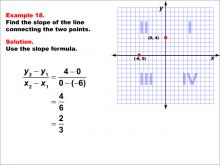
|
Math Example--Coordinate Geometry--Slope Formula: Example 18 | Math Example--Coordinate Geometry--Slope Formula: Example 18TopicSlope Formula DescriptionThis example demonstrates the calculation of slope for a line connecting two points: (-6, 0) and (0, 4) on a Cartesian plane. Applying the slope formula, we find that the slope is (4 - 0) / (0 - (-6)) = 4 / 6 = 2 / 3. The slope formula is a fundamental concept in coordinate geometry, helping us understand the steepness and direction of lines. This example shows how to handle points with both positive and negative coordinates when calculating slope, resulting in a positive fraction. |
Slope |
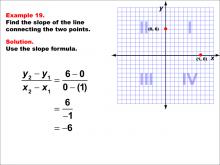
|
Math Example--Coordinate Geometry--Slope Formula: Example 19 | Math Example--Coordinate Geometry--Slope Formula: Example 19TopicSlope Formula DescriptionThis example illustrates the calculation of slope for a line connecting two points: (1, 0) and (0, 6) on a Cartesian plane. Applying the slope formula, we find that the slope is (6 - 0) / (0 - 1) = 6 / -1 = -6. The slope formula is a crucial concept in coordinate geometry, helping us understand the steepness and direction of lines. This example demonstrates how to handle points with both positive and negative coordinates when calculating slope, resulting in a negative integer slope. |
Slope |
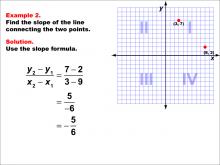
|
Math Example--Coordinate Geometry--Slope Formula: Example 2 | Math Example--Coordinate Geometry--Slope Formula: Example 2TopicSlope Formula DescriptionThis example illustrates the calculation of slope between two points (3, 7) and (9, 2) on a coordinate grid. The slope formula is applied to find that the slope is (7 - 2) / (3 - 9) = 5 / -6 = -5 / 6. Understanding the slope formula is crucial in coordinate geometry as it helps describe the steepness and direction of a line. This concept is widely used in various mathematical applications and real-world scenarios. |
Slope |
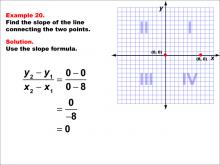
|
Math Example--Coordinate Geometry--Slope Formula: Example 20 | Math Example--Coordinate Geometry--Slope Formula: Example 20TopicSlope Formula DescriptionThis example demonstrates the calculation of slope for a horizontal line connecting points (0, 0) and (8, 0) on a Cartesian plane. When we apply the slope formula, we find that the slope is (0 - 0) / (8 - 0) = 0 / 8 = 0. The slope formula is a key concept in coordinate geometry, helping us understand the steepness and direction of lines. This particular example highlights a special case where the line is horizontal and lies on the x-axis, resulting in a slope of zero. |
Slope |

|
Math Example--Coordinate Geometry--Slope Formula: Example 21 | Math Example--Coordinate Geometry--Slope Formula: Example 21TopicSlope Formula DescriptionThis example illustrates the calculation of slope for a vertical line connecting points (0, 0) and (0, 6) on a Cartesian plane. When we apply the slope formula, we find that the slope is (6 - 0) / (0 - 0) = 6 / 0, which is undefined. The slope formula is a fundamental concept in coordinate geometry, helping us understand the steepness and direction of lines. This particular example highlights a special case where the line is vertical and lies on the y-axis, resulting in an undefined slope due to division by zero. |
Slope |
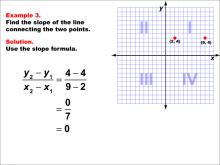
|
Math Example--Coordinate Geometry--Slope Formula: Example 3 | Math Example--Coordinate Geometry--Slope Formula: Example 3TopicSlope Formula DescriptionThis example demonstrates the calculation of slope for a horizontal line connecting points (2, 4) and (9, 4) on a coordinate grid. When we apply the slope formula, we find that the slope is (4 - 4) / (9 - 2) = 0 / 7 = 0. The slope formula is a fundamental concept in coordinate geometry, helping us understand the steepness and direction of lines. This particular example highlights a special case where the line is horizontal, resulting in a slope of zero. |
Slope |
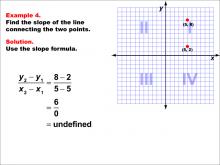
|
Math Example--Coordinate Geometry--Slope Formula: Example 4 | Math Example--Coordinate Geometry--Slope Formula: Example 4TopicSlope Formula DescriptionThis example illustrates the calculation of slope for a vertical line passing through points (5, 8) and (5, 2) on a coordinate grid. When we apply the slope formula, we find that the slope is (8 - 2) / (5 - 5) = 6 / 0, which is undefined. The slope formula is a key concept in coordinate geometry, helping us understand the steepness and direction of lines. This particular example highlights a special case where the line is vertical, resulting in an undefined slope. |
Slope |
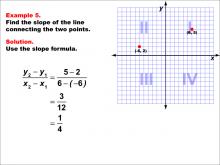
|
Math Example--Coordinate Geometry--Slope Formula: Example 5 | Math Example--Coordinate Geometry--Slope Formula: Example 5TopicSlope Formula DescriptionThis example demonstrates the calculation of slope for a line connecting two points in different quadrants: (-6, -2) in Quadrant III and (6, 5) in Quadrant I. Applying the slope formula, we find that the slope is (5 - (-2)) / (6 - (-6)) = 7 / 12 = 1 / 4. The slope formula is a crucial concept in coordinate geometry, helping us understand the steepness and direction of lines. This example shows how to handle negative coordinates and points in different quadrants when calculating slope. |
Slope |
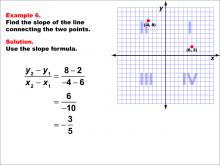
|
Math Example--Coordinate Geometry--Slope Formula: Example 6 | Math Example--Coordinate Geometry--Slope Formula: Example 6TopicSlope Formula DescriptionThis example illustrates the calculation of slope for a line connecting two points in different quadrants: (-4, 8) in Quadrant II and (6, 2) in Quadrant I. Applying the slope formula, we find that the slope is (8 - 2) / (-4 - 6) = 6 / -10 = -3 / 5. The slope formula is a fundamental concept in coordinate geometry, helping us understand the steepness and direction of lines. This example demonstrates how to handle points in different quadrants and interpret a negative slope. |
Slope |
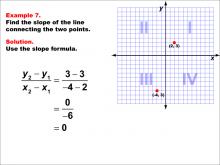
|
Math Example--Coordinate Geometry--Slope Formula: Example 7 | Math Example--Coordinate Geometry--Slope Formula: Example 7TopicSlope Formula DescriptionThis example demonstrates the calculation of slope for a horizontal line connecting two points: (-4, 3) in Quadrant II and (2, 3) in Quadrant I. When we apply the slope formula, we find that the slope is (3 - 3) / (-4 - 2) = 0 / -6 = 0. The slope formula is a key concept in coordinate geometry, helping us understand the steepness and direction of lines. This particular example highlights a special case where the line is horizontal, resulting in a slope of zero, even when the points are in different quadrants. |
Slope |
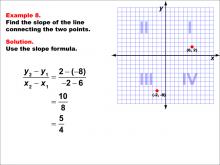
|
Math Example--Coordinate Geometry--Slope Formula: Example 8 | Math Example--Coordinate Geometry--Slope Formula: Example 8TopicSlope Formula DescriptionThis example illustrates the calculation of slope for a line connecting two points in different quadrants: (-2, -8) in Quadrant III and (6, 2) in Quadrant I. Applying the slope formula, we find that the slope is (2 - (-8)) / (6 - (-2)) = 10 / 8 = 5 / 4. The slope formula is a crucial concept in coordinate geometry, helping us understand the steepness and direction of lines. This example shows how to handle negative coordinates and points in different quadrants when calculating slope. |
Slope |
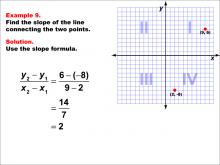
|
Math Example--Coordinate Geometry--Slope Formula: Example 9 | Math Example--Coordinate Geometry--Slope Formula: Example 9TopicSlope Formula DescriptionThis example demonstrates the calculation of slope for a line connecting two points: (9, 6) and (2, -8) on a Cartesian plane. Applying the slope formula, we find that the slope is (6 - (-8)) / (9 - 2) = 14 / 7 = 2. The slope formula is a fundamental concept in coordinate geometry, helping us understand the steepness and direction of lines. This example shows how to handle points with both positive and negative coordinates when calculating slope. |
Slope |
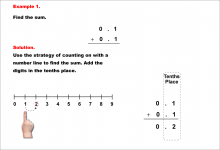
|
Math Example--Decimal Concepts--Adding Decimals to the Tenths (No Regrouping)--Example 1 | Math Example--Decimal Concepts--Adding Decimals to the Tenths (No Regrouping)--Example 1TopicAdding Decimals DescriptionThis math example demonstrates the addition of decimals 0.1 and 0.1 using a number line. The image visually represents the sum by highlighting the point at 0.2 on the number line. Students are encouraged to find the sum by adding the digits in the tenths place, reinforcing the concept of decimal place value. This simple yet effective visualization helps learners understand how decimals can be added just like whole numbers, but with careful attention to decimal point alignment. |
Add and Subtract Decimals and Place Value |
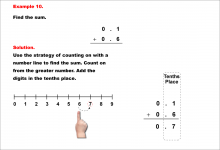
|
Math Example--Decimal Concepts--Adding Decimals to the Tenths (No Regrouping)--Example 10 | Math Example--Decimal Concepts--Adding Decimals to the Tenths (No Regrouping)--Example 10TopicAdding Decimals DescriptionThis example illustrates how to add decimals like 0.1 and 0.6 using a number line. Through using number lines and column techniques, students grasp decimal addition. The image shows adding 0.1 and 0.6 using a number line, highlighting movement from 6 to 7. This visual approach helps students understand how to count from the greater number when adding decimals to find the sum of 0.7. |
Add and Subtract Decimals and Place Value |

|
Math Example--Decimal Concepts--Adding Decimals to the Tenths (No Regrouping)--Example 11 | Math Example--Decimal Concepts--Adding Decimals to the Tenths (No Regrouping)--Example 11TopicAdding Decimals DescriptionThis example illustrates adding 0.6 and 0.1 using a number line, showing movement from 6 to 7. The visual representation helps students understand how to count from the greater number when adding decimals to the tenths. This method reinforces the concept of decimal place value and demonstrates how to add decimals without the need for regrouping. |
Add and Subtract Decimals and Place Value |
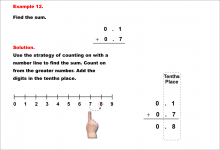
|
Math Example--Decimal Concepts--Adding Decimals to the Tenths (No Regrouping)--Example 12 | Math Example--Decimal Concepts--Adding Decimals to the Tenths (No Regrouping)--Example 12TopicAdding Decimals DescriptionThis example demonstrates adding 0.1 and 0.7 using a number line, illustrating movement from 7 to 8. The visual aid helps students understand how to count from the smaller number to the larger one when adding decimals to the tenths. This method reinforces the concept of decimal place value and shows how to add decimals without regrouping. |
Add and Subtract Decimals and Place Value |
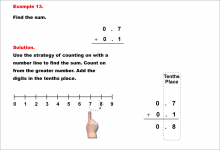
|
Math Example--Decimal Concepts--Adding Decimals to the Tenths (No Regrouping)--Example 13 | Math Example--Decimal Concepts--Adding Decimals to the Tenths (No Regrouping)--Example 13TopicAdding Decimals DescriptionThis example illustrates adding 0.7 and 0.1 using a number line, showing movement from 7 to 8. The visual representation helps students understand how to count from the greater number when adding decimals to the tenths. This method reinforces the concept of decimal place value and demonstrates how to add decimals without the need for regrouping. |
Add and Subtract Decimals and Place Value |
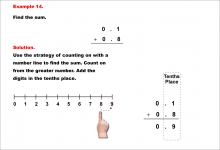
|
Math Example--Decimal Concepts--Adding Decimals to the Tenths (No Regrouping)--Example 14 | Math Example--Decimal Concepts--Adding Decimals to the Tenths (No Regrouping)--Example 14TopicAdding Decimals DescriptionThis example demonstrates adding 0.1 and 0.8 using a number line, illustrating movement from 8 to 9. The visual aid helps students understand how to count from the smaller number to the larger one when adding decimals to the tenths. This method reinforces the concept of decimal place value and shows how to add decimals without regrouping. |
Add and Subtract Decimals and Place Value |
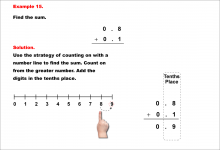
|
Math Example--Decimal Concepts--Adding Decimals to the Tenths (No Regrouping)--Example 15 | Math Example--Decimal Concepts--Adding Decimals to the Tenths (No Regrouping)--Example 15TopicAdding Decimals DescriptionThis example illustrates adding 0.8 and 0.1 using a number line, demonstrating movement from 8 to 9. The visual representation helps students understand how to count from the greater number when adding decimals to the tenths. This method emphasizes the importance of identifying the larger decimal and using it as a starting point for addition. |
Add and Subtract Decimals and Place Value |
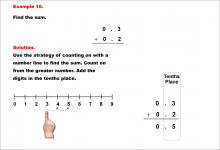
|
Math Example--Decimal Concepts--Adding Decimals to the Tenths (No Regrouping)--Example 16 | Math Example--Decimal Concepts--Adding Decimals to the Tenths (No Regrouping)--Example 16TopicAdding Decimals DescriptionThis example showcases the addition of 0.3 and 0.2 using a number line, illustrating movement from 3 to 5. The visual representation helps students understand how to count from the greater number when adding decimals to the tenths. This method reinforces the concept of decimal place value and demonstrates how to add decimals without regrouping. |
Add and Subtract Decimals and Place Value |